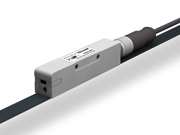I built a rather cheap(~€100) 3 axis CNC router for my workshop for cutting wood and aluminium in all sorts of fancy ways. It works great for most stuff but for things that require high precision, its always a little off.
For example, if I make it do 2 identical cuts, one right after another, the difference in any axis can be up to 1mm. Not too bad for wood, considering the total work area is 800x800x400mm and the size of things I make but kind of a problem for aluminium pieces that have to fit together.
It can be worse if significant amount of time/work is between the 2 cuts. I've had identical cuts made a few days apart for replacement parts differ by up to ~2.5mm on large pieces.
Now I figured I could get better rails, better bearings, engines, whatever to try and make it more consistent but I think the biggest gains could be had by having the ability to calibrate and check it in software.
TLDR: So what do people use for measuring distances of up to 1000mm with lets say 0.1mm precision?
I looked around chinese estores but all I found was laser sensors for large distances, like 100m with precision +- 0.2m and ultrasonic proximity sensors for shorter distances but pretty terrible precision.
They were pretty cheap though (<€10) which gives me hope. I also have the advantage of having complete physical control over both the points that I want to measure the distance between instead of just one.






